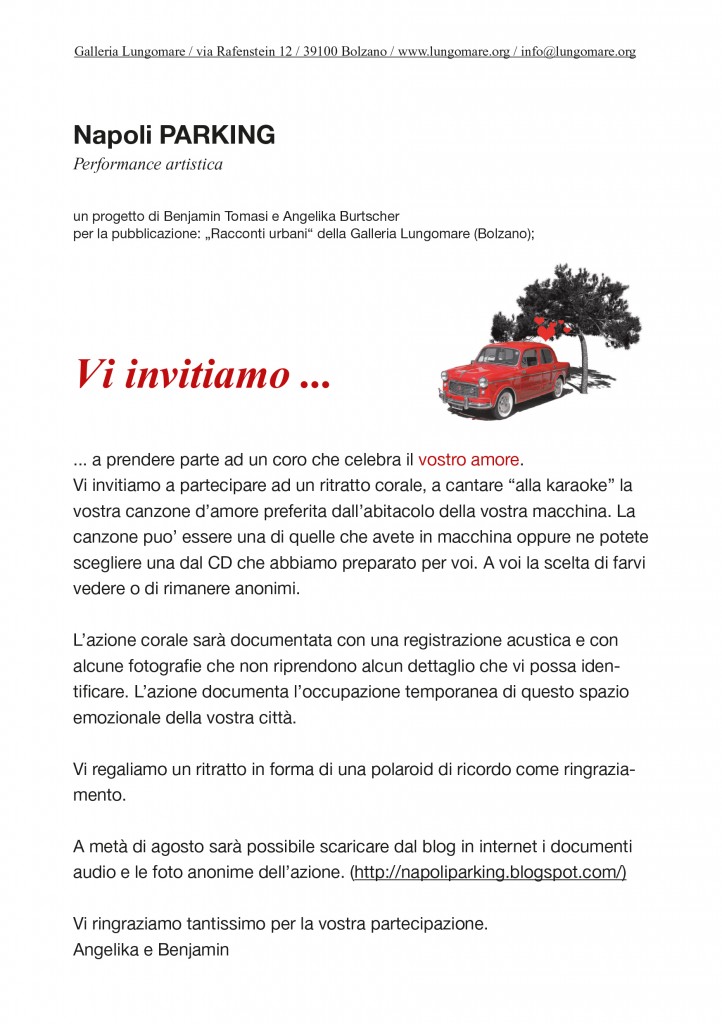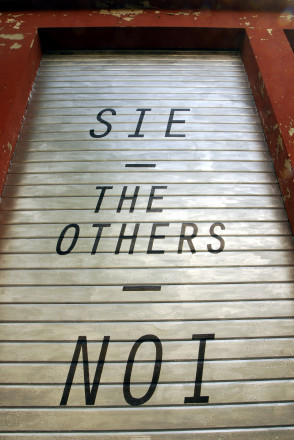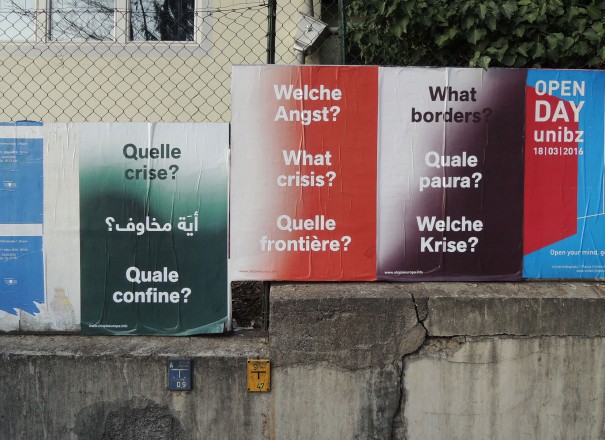Osservatorio urbano # 2
Traum Stadt Wir – possibilities of urban perception
The book bases on the work of Osservatorio Urbano/Lungomare, a temporary network dealing with urban strategies promoted 2005 by Lungomare. In the project the concentration was deliberately focalised onto aspects such as spontaneity, emotions and unpredictability. Moreover, in order to widen the proposed point of view and to achieve highly interdisciplinary results, word was passed onto other disciplines and other outlooks.
The Osservatorio Urbano/Lungomare project has raised many questions and generated in the project’s curators the desire to define a space within which to deepen the themes outlined in the 2005 project. In this book space is left for thoughts about the city to alternate freely and become independent city stories avoiding any codified technique of observation. The publication presents artistic practices in urban territories, compares different theories, shows approaches which underline the possibilities represented by the extension of collective spaces through processes of spontaneous appropriation, it deals with ways of seeing and slowly observing, it deals with a choral reading by the inhabitants, it invites the reader to gain a perception of the city through his senses and gathers images which describe the urban context.
With contributions of: Alessandro Banda, Francesco Careri, Carl Fingerhuth, Francesco Jodice, Arno Ritter, Joseph Rykwert, Ferdinand Schmatz, Boris Sieverts, Benjamin Tomasi, Heimo Zobernig
TRAUM STADT WIR – Möglichkeiten urbaner Wahrnehmung / SOGNO CITTÀ NOI – Esercizi di percezione urbana / published by Studienverlag (Innsbruck/Vienna/Bolzano), 204 pages, ISBN 978-3-7065-4408-5, curated by: Angelika Burtscher, Manuela Demattio and Roberto Gigliotti.
Lungomare
In collaboration with:
Publisher Studienverlag (Innsbruck, Vienna, Bolzano)
Alessandro Banda
One or two years before he died (we all know how) Pier Paolo Pasolini took part in a television programme. It is well known that Pasolini hated television, yet for one of the many contradictions that characterized his insuppressibility, he nevertheless participated. The transmission in question was called -and I … What was it about? A celebrated personality of literature, politics, or show business was asked to state their preferences in the field of the arts, and more precisely, to report a work that was particularly dear to them: a loved painting, fresco, or monument. Pasolini, who was no amateur in this area, having been the student of a master like Roberto Longhi, chose not a picture or a so-called “work of art”, but a city: in fact the shape of a city. The shape of Orte, given that in 1973 or 1974 that small town known mainly as a rail hub was beginning to have its integrity threatened. On the small screen you could see the poet indicating the cobblestones of a small alley in Orte, or a chipped piece of yellowish wall, and with a sigh saying: “this is also part of the form of Orte, and I would like it to be saved.”
Francesco Careri
on the first missed meetings
None of us had ever had direct contact and so the process we went through was important for our common growth. We started from scratch. The first transurbanza took place in Rome in 1995. We passed in front of the entrance to the Quintiliani field but we didn’t enter. It was late afternoon, we were tired and looking for a place to camp for the night. We stopped on a football pitch that Albanians had created for their children. I remember that we talked to a beautiful tall man with long hair, deep blue eyes, and an air of wisdom. He was like Melquiades, the gypsy from One Hundred Years of Solitude by García Márquez, who brought news of the outside world to Macondo, and who, at the beginning of the book amazed the village by showing them ice. Melquiades and the other Albanians had taken an old farmhouse and transformed it into a home for a number of families, with a welcoming, warm and cosy atmosphere. At our request to sleep on the football pitch they responded that they were happy to have guests, that we could put up our tents and nobody would mind.
Carl Fingerhuth
The era of the Modern has been an exploration into the depths of human mental potential. It has been an age dominated by the investigation, understanding, and description of the physical world. In particular, space has been one of the central areas of research, as much astronomy and physics as architecture and urbanism. In the transition from the mythic structure to the mental structure of consciousness, characteristic of the Modern, the three-dimensional form of space has been recognized and analysed. Artists have created views of perspective, fixing the position of the observer and making the vanishing point dependent on this position. The buildings and cities have been built based on projects where the ideal form has been generated by human thought.
Francesco Jodice
Photography and collective imagination
On November 22, 1963 the Texan entrepreneur Abraham Zapruder, a Russian Jew born in the city of Kovel in the Ukraine and emigrating to Brooklyn when still a child, filmed more or less accidentally with his Bell & Howell 8mm camera, the murder of J.F. Kennnedy in Dallas. By breaking up the short film into individual stills, the Garrison District Attorney disclosed the pack of lies concealed by the Warren Commission, and revealed the involvement of the secret services, military, and members of parliament in the conspiracy, changing forever the perception that Americans had of their history.
Read more: Die unerträgliche Existenz der Städte: Fotografie und kollektive Imagination
An interview with Arno Ritter
by Angelika Burtscher
“I think the city is also defined by the architecture and buildings that serve as a background and designed space, making possible urban life. In fact, an important element that characterizes the urban dimension is the space between the buildings – the streets, squares and public and private spaces. When we think of a city, we don’t remember individual buildings, but the spaces between them (interstices), their atmosphere, which also refers to other atmospheres, in part imprinted in the unconscious. You could also speak of the “genius loci,” the aura or fabric of a city, almost indefinable, or of an urban grammar. A city, whether large or small, cannot invent or produce the urban dimension, even less represent it, because the city is invisible. ”
A conversation with Joseph Rykwert
by Roberto Gigliotti
“From my perspective, tourism is a fundamentally destructive civil and corporate function. Especially because tourism is seasonal, and the city is filled during the tourist season and then emptied again. You could say the same thing about University; students are there during the semesters. This is the case in all university towns: Cambridge, Oxford, Cambridge Massachusetts, New Haven, Alcalà or Padua. However, around the university a life develops that is not seasonal. As is, for example, the entire university infrastructure and faculty permanently integrated into the city.”
Ferdinand Schmatz
Work of chance or of plan, of the senses or of the mind. What is the city for us?
In the middle of me lies a forest, it spreads itself out, the boughs branch out, step out of my body, push into the asphalt, fissures are created and grass begins to sprout in them. I wished to grow together with the city to which I wanted to travel, so I unbound myself and bound myself in it. Even my head opened up and provided a free landscape. What it displayed were hills. Valleys, caves, niches, as well as rows of trees, avenues, the highest level of order. I picked one out and believed I was in district of the suburbs – or was it the district of the mind. How can I get out of there? There were twists, I sprang over them and ran dead straight away. I wanted to enter a centre, to reach the core – and found myself at the threshold of a gate.
With Boris Sieverts through southern Luxembourg
We go on and reach the railway tracks of the Luxembourg-Belgium rail line. Opposite us, we see a huge industrial plateau, cleaned up and seeded with grass. It was the largest industrial area of France. There, in Longwy in the eighties major industrial disputes took place. Today this large area is both extremely bizarre and to some extent beautiful. On the plateau, huge lawns lie next to commercial zones. Together with Luxembourg and the Belgian side, this represents the “Pol européen de développement.” There are three versions, how big business is dealt with: The French let it disappear without a trace, the Belgians let it fall fallow, as it is here, and the Luxembourger – who are doing well economically – plan and convert the land. Luxembourgers are quick and implement their plans; they are capable of transforming industrial society into a service society
an intervention by Benjamin Tomasi
curated by Angelika Burtscher
The inhabitants of Naples often talk with nostalgia about the Parco delle Rimembranza, what is now the Parco Virgiliano, and which, until the mid-nineties, was open for loving couples and their cars. The place is said to have been romantic. It was a sportsground, a location for walks, a place for public concerts and at the same time a place for love.

Benjamin Tomasi: Napoli Parking
TRAUM STADT WIR on issuu.com
Design: Lupo & Burtscher
Autonomous Province of Bozen/Bolzano-South Tyrol, Culture Departments
Fondazione Cassa di Risparmio
City of Bolzano, Cultures Department
Autonomous Region Trentino-Alto Adige
Supporter 2008:
Parkhotel Laurin, EOS -Solution for Business, Heinrich Gasser
What´s on
EXHIBITION :: Binta Diaw :: Collective Practices – A Living Experience of Feeling ListenedAbout Lungomare
Lungomare, a cultural association founded in Bolzano in 2003, was created from the desire and necessity to open a space in which to share differences, experiences, opinions and desires, a space in which to make the link between cultural production and the political and social dimension. Lungomare undertakes projects that investigate and test possible relationships between design, architecture, urban planning, art and theory, the results of which are presented in different formats: public discussions, conferences, publications, exhibitions and interventions in public spaces. All these formats are characterised by the intention to interact with cultural and socio-political processes relating to the region in which Lungomare is located.
Currently Lungomare’s activities focus on long-term residency projects, a format whereby Lungomare invites guests to engage and interact within the context of South Tyrol. Lungomare’s activities are based on three principles: specific attention to the context in which the association’s projects are undertaken, the transdisciplinary approach that distinguishes these projects, and reflection on the role of Lungomare as a cultural institution in connection with the region in which it operates.
Territory
Lungomare is located at the edge of Bolzano, the capital of South Tyrol, and relates to the context in which it operates, attempting to highlight the dynamics of change. Large urbanized areas alternate with broad areas of intensive cultivation and yet others of picturesque landscape, all of which penetrate the centre of the city. The city is surrounded by mountains and this is one of the reasons why the tourism industry has become a driving force in this locality. The demographic structure of the city has been characterized for a long time by the coexistence of two populations, those speaking German and those speaking Italian. However, the social and demographic composition of Alto Adige Südtirol is changing. Migrants, including those from non-European countries are making their way to the area to settle, whilst others, including political refugees, are flowing through the region.



